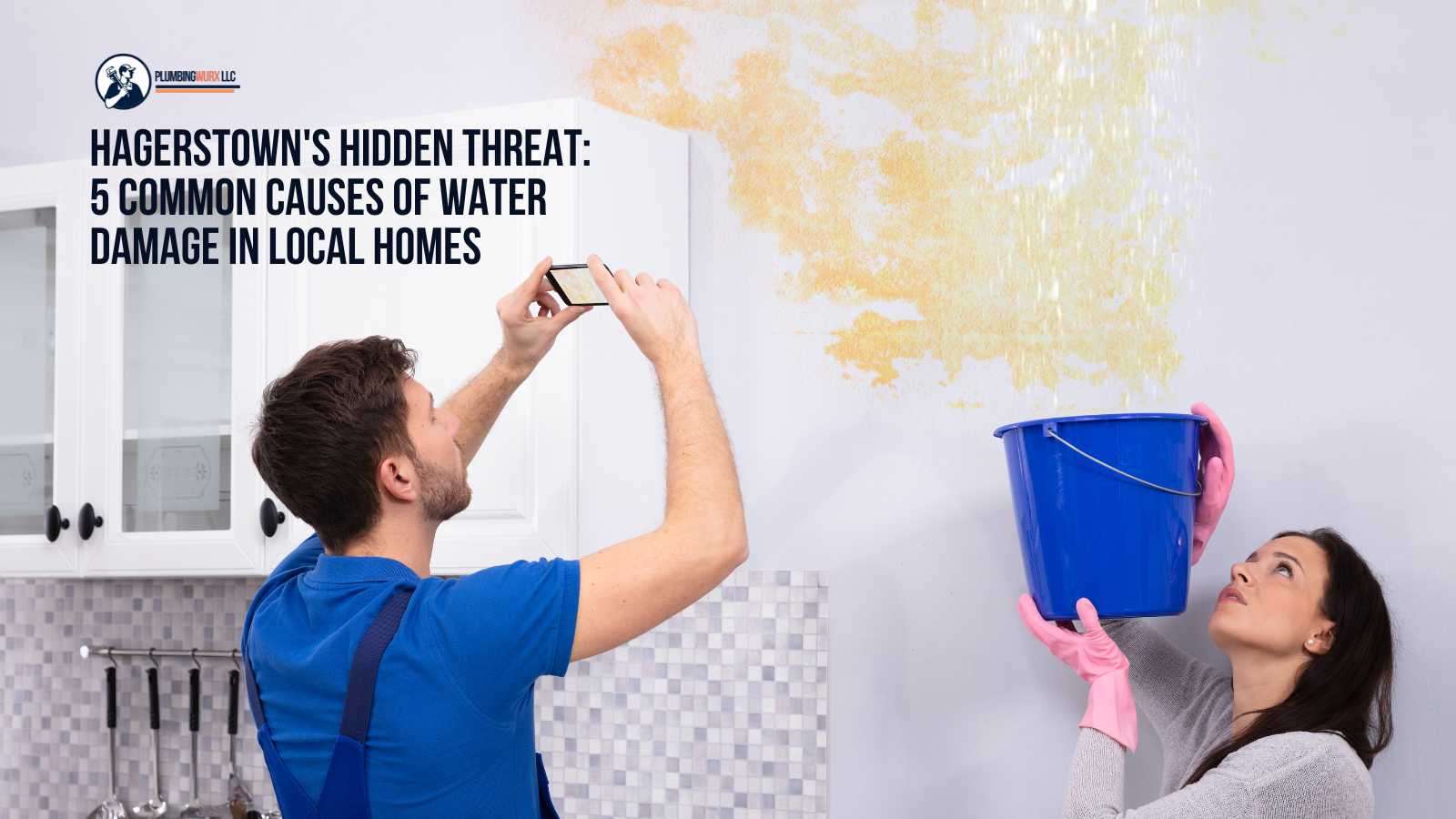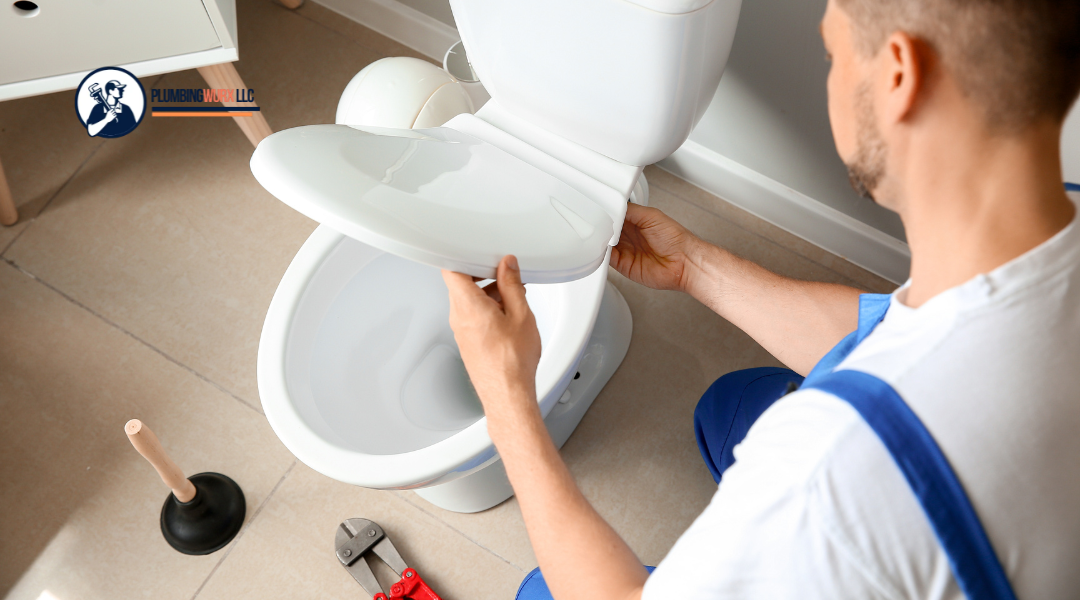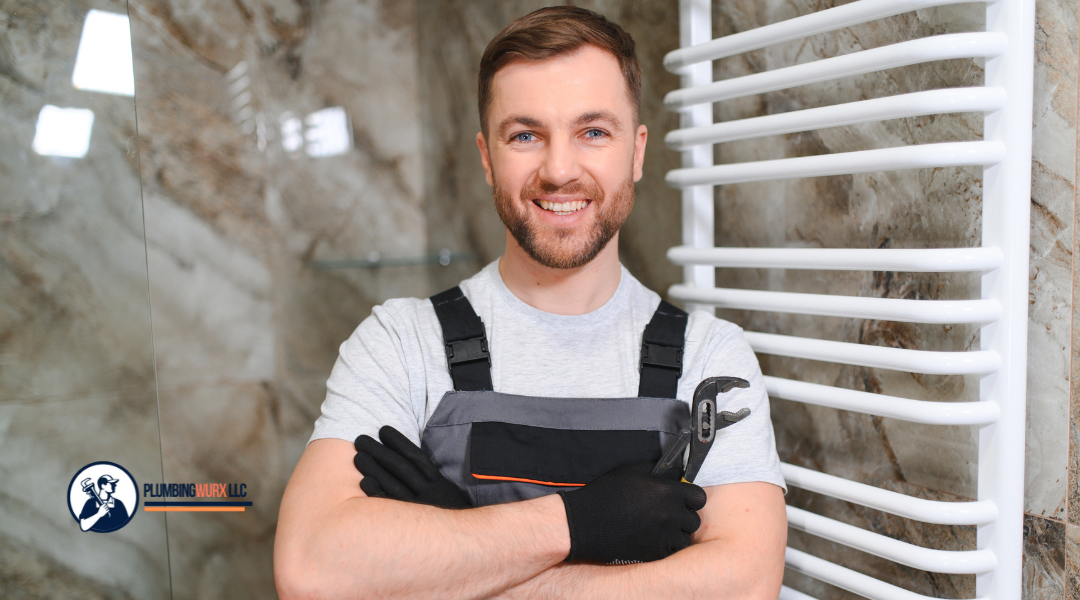If you’re a homeowner, chances are you’ve had a brush with water damage—or know someone who has. It’s one of those sneaky problems that often hides in plain sight, quietly wreaking havoc until it’s too late.
In Hagerstown, where the seasons bring everything from heavy rains to freezing winters, homes are particularly vulnerable. Whether it’s a burst pipe during a cold snap or a leaky roof after a storm, water damage can strike when you least expect it.
But don’t worry; as professional plumbers, we’re here to help you identify the culprits before they turn your cozy home into a costly repair project.
Top 5 Causes of Water Damage in Hagerstown Homes
1. Leaky or Burst Pipes: A Common Plumbing Hazard
Leaky or burst pipes are one of the leading causes of water damage. Plumbing systems are the lifeblood of any house, but over time, wear and tear, changes in water pressure, and temperature fluctuations can take their toll.
Common factors that contribute to pipe failures include:
- Aging Pipes: Many homes feature plumbing systems that are decades old. Older pipes made of materials like galvanized steel or cast iron are prone to corrosion and eventual failure.
- Clogs and Pressure Build-Up: Blockages in the plumbing system can increase water pressure, leading to pipe damage. Even minor leaks can go unnoticed until they cause significant issues.
- Freezing Temperatures: During Hagerstown’s colder months, water inside pipes can freeze and expand, leading to bursts. Homes without adequate pipe insulation are particularly at risk.
Leaks and bursts not only waste water but can also cause structural damage to walls, floors, and ceilings if left unaddressed. Even a slow drip can weaken the foundation of a home over time.
2. Basement Moisture: Poor Waterproofing Solutions
Basements are inherently vulnerable to water damage due to their location below ground level, where they are exposed to groundwater and rain runoff. Poor waterproofing practices or outdated systems often exacerbate the problem, leading to persistent moisture issues.
Key contributors to basement water damage include:
- Hydrostatic Pressure: The natural buildup of water in the soil around a home exerts pressure on basement walls and floors, allowing water to seep through cracks or porous materials.
- Improper Grading: Many homes suffer from grading issues that direct water toward the foundation instead of away from it, increasing the risk of flooding.
- Faulty or Missing Drainage Systems: French drains, sump pumps, and other drainage solutions are essential for keeping basements dry. Without these systems or with improperly installed ones, water intrusion becomes a frequent issue.
- High Humidity Levels: Even without visible leaks, moisture in the air can condense on cooler basement surfaces, leading to mold growth and long-term damage to drywall and flooring.
3. Roof and Ceiling Damage: Undetected Leaks and Missing Shingles
The roof is a home’s first line of defense against the elements, but even minor issues can lead to significant water damage over time. Undetected leaks and missing shingles are among the most common causes of roof and ceiling damage.
Key factors contributing to roof-related water damage include:
- Worn or Damaged Shingles: Over time, shingles can become brittle, crack, or blow away in strong winds, leaving gaps for water to penetrate.
- Flashing Issues: Flashing around chimneys, vents, and skylights can deteriorate or become improperly sealed, allowing water to seep into the attic or ceiling.
- Undetected Leaks: Slow, hidden leaks in the roof can go unnoticed for months, leading to saturated insulation, weakened structural components, and ceiling stains.
- Ice Dams in Winter: In colder months, melting snow can refreeze at roof edges, creating ice dams that prevent proper drainage and force water back under shingles.
4. Severe Weather Events: Flooding and Heavy Rainfall
Hagerstown’s climate and seasonal weather patterns can bring heavy rainfall, thunderstorms, and even occasional flooding, all of which pose a significant risk to local homes. Severe weather events can overwhelm drainage systems and expose vulnerabilities in a property’s defenses.
Common weather-related causes of water damage include:
- Flooded Basements and Crawl Spaces: Intense rainfall can lead to rapid water accumulation around a home’s foundation, overwhelming sump pumps or drainage systems, and basement flooding.
- Overloaded Gutters and Downspouts: Gutters clogged with debris cannot channel water away effectively, leading to water pooling near the foundation or seeping into walls.
- Wind-Driven Rain: High winds can push rainwater into crevices, cracks, or improperly sealed windows and doors.
- Localized Flash Flooding: Urban areas with poor drainage systems may experience sudden flooding during heavy storms, putting homes at risk.
Severe weather can cause immediate and long-term damage if water infiltration is not promptly addressed. The unpredictability of storms makes preparation crucial for homeowners.
5. Faulty Appliances: Hidden Risks from Washing Machines and Water Heaters
Household appliances that use water are convenient for modern living but can also present hidden risks if not properly maintained. Washing machines, water heaters, and dishwashers are among the most common culprits behind water damage.
Key appliance-related risks include:
- Worn Hoses and Connections: Over time, rubber or plastic hoses on washing machines and dishwashers can degrade, crack, or loosen, leading to slow leaks or sudden bursts.
- Aging Water Heaters: Water heaters have a limited lifespan, and as they age, tanks can corrode and develop leaks, potentially releasing large amounts of water.
- Overflows and Malfunctions: Malfunctions, such as stuck float switches or clogged drainage systems, can cause appliances to overflow, resulting in localized flooding.
- Neglected Maintenance: Regular servicing is often overlooked, leaving small issues like mineral buildup or blockages to worsen and cause water leaks.
How to Spot Early Signs of Water Damage
One of the most common signs is discoloration or stains on walls and ceilings, often accompanied by a musty odor. These are telltale indicators of a hidden leak or moisture buildup.
Changes in flooring can also signal water damage. Warped, buckling, or soft spots in hardwood, laminate, or carpeted areas may indicate water infiltration below the surface. Similarly, bubbling or peeling paint and wallpaper often indicate excess moisture trapped in the walls.
Another key sign is an unexplained increase in your water bill. A sudden spike could indicate a hidden leak in your plumbing system, wasting water and potentially causing damage. Listen for unusual sounds, such as dripping or running water, even when fixtures are turned off. These subtle noises often signal a problem lurking out of sight.
The Long-Term Effects of Ignoring Water Damage
At PlumbingWurx, we’ve seen firsthand how ignoring water damage can turn a minor issue into a homeowner’s nightmare. Water damage isn’t just about puddles on the floor or unsightly stains on the ceiling. Over time, it can compromise the very structure of your home. What starts as a small leak can seep into wooden beams, drywall, and foundations, weakening the materials and leading to costly repairs.
Unaddressed water damage often creates the perfect environment for mold and mildew growth. This not only impacts your home’s aesthetic but also poses serious health risks. Mold spores can trigger allergies, asthma, and other respiratory issues, especially for children or those with pre-existing conditions.
We’ve encountered cases where water damage, left untreated, caused floors to warp, roofs to sag, and even led to electrical hazards. Water has a way of infiltrating every corner, and the longer it sits, the more extensive—and expensive—the damage becomes. As plumbing professionals, we cannot stress enough the importance of addressing water damage promptly to avoid these long-term consequences.
Protecting Your Home From Water Damage
Protecting your home from water damage requires more than good maintenance—it’s necessary to safeguard your investment.
We’ve helped countless Hagerstown homeowners prevent water disasters with proactive measures and expert advice. The key is understanding your home’s vulnerabilities and taking steps to fortify them.
Regular inspections of plumbing systems, roofs, and basements can uncover potential problems before they escalate. For instance, a small leak in a pipe or roof might not seem urgent, but catching it early can save thousands in repairs. Routine maintenance, like clearing gutters or servicing sump pumps, plays a significant role in directing water away from your home and keeping vulnerable areas dry.
We also emphasize the importance of modern upgrades. Many older homes in Hagerstown still rely on outdated plumbing systems or lack essential drainage solutions like French drains or waterproofing. Investing in these updates now can prevent headaches later. With PlumbingWurx’s expert services, protecting your home from water damage becomes seamless!
Get Expert Help From PlumbingWurx Today!
We specialize in identifying and addressing water damage early to prevent small issues from becoming major disasters. If you suspect any of these signs in your home, our team is ready to investigate and provide the expert solutions you need.
Call us now or visit our website to get started! With our experience in both residential and commercial plumbing, we’re equipped to handle all types of plumbing concerns. Don’t let a minor issue become a big problem. Contact us today at (301) 264-7577 or visit us at 1044 Virginia Ave, Hagerstown, MD 21740. We’re a family-owned business and pride ourselves on our quality craft and top-notch customer service!












0 Comments